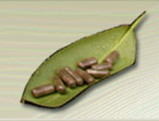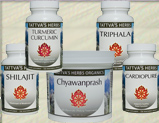 Loading... Please wait...
Loading... Please wait...Providing 25 Years Of Premium Service
Storewide Sale - Save 20%
Blog - ayurvedic weight management
Coleus forskohlii: Fat-Fighting and More
Posted by Vladimir Badmaev, MD, PhD and Muhammed Majeed, PhD on 8th Dec 2009
Coleus forskohlii, is a member of the mint family (Lamiaceae). As part of a long-standing tradition in India, C. forskohlii roots have been used as a marinated food, or pickle, that is commonly eaten as part of a vegetarian meal. Upon closer investigation into the plant’s pharmacological properties, it was revealed that C. forskohlii roots contain forskolin, a compound that belongs to the chemical class of diterpenes.
It is the only plant-derived compound presently known to directly stimulate the enzyme adenylate cyclase, and subsequently cyclic AMP. Cyclic AMP is also nicknamed the ‘second messenger,’ referring to its broad range of activity in the body’s life-sustaining reactions.
In the last 20 years, forskolin has been successfully evaluated in numerous clinical studies, including bronchial asthma, cardiovascular health, glaucoma, sexual dysfunction in men and dermatological diseases. In the cited clinical studies, no adverse effects of forskolin administration were reported in spite of the fact that different doses, forms of administration and routes of administration were employed in these studies.
A toxicological study performed by a specialized, independent, U.S.-based laboratory indicates that an extract of C. forskohlii roots standardized to 10 percent forskolin is a relatively safe product with an oral LD50 above 2,000 mg/kg (2,000 mg/kg did not produce any mortality in experimental animals). The AMES test, a bacteria mutagenicity test, performed at the same time as the LD50 study, did not show mutagenic properties in the same C. forskohlii extract.
Coleus forskohlii Supplement Applications Physiological, biochemical and clinical effects of forskolin include the following:
• Red blood cells: prevention of membrane lipids peroxidation in hyperglycemia
• Adipocytes: increased lipolysis
• Pancreas: potentiation of insulin secretion
• Thyroid: increase/potentiation THS, T3, T4
• HPA axis: increase in CRH, ACTH, steroid genesis
• Leydig cells: testosterone production
• Cardiovascular system: positive inotropic, chronotropic, and hypotensive effects, and improved coronary blood flow and myocardial functions
• Respiratory tract: broncholytic, and anti-asthmatic
• Genitourinary tract: treatment of vasculogenic impotency in men
• Eye: decrease in intraocular pressure
• Skin: management of cellulite, and psoriasis
• New application for Coleus forskohlii: reducing body fat while maintaining lean body mass. While the use of forskolin containing Coleus forskohlii extracts for increasing lean body mass, fat loss and weight loss is a topic that is receiving increased attention of late, it should be noted that this application is covered by a U.S. patent granted to Sabinsa Corp. the use of which claims apply exclusively to the ForsLean® brand of Coleus extracts.
One of the emerging clinical applications for C. forskohlii is for nutritional support in weight management. The rationale for this novel application has been derived from the lipolytic mechanism (a biochemical pathway to metabolize lipids in the body) of forskolin fueled by forskolin-generated cyclic AMP and phosphorylation of hormone sensitive lipase (HSL). Sabinsa Corporation owns the patent on C. forskohlii and its constituent, forskolin, for improving lean body mass.
Maintaining or improving lean body mass while shedding extra pounds of adipose tissue has been advocated by the Centers for Disease Control. Lean body mass is important because it has been recently recognized as an independent, positive predictor of one’s cardiovascular health and overall health.
The lipolytic potential of forskolin has been studied in vitro with human adipose tissue. One study compared the activity of HSL in adipose tissue and the regulatory effect of various compounds in young (25-33 year old) vs. middle-aged (52-62) men. No difference was observed in the lipase activity of adipose tissue, nor the number or function of beta-adrenergic receptors (receptors necessary for lipolytic response) in young vs. middle-aged subjects.
However, lipolysis induced by isoproterenol (beta-adrenergic receptor agonist), forskolin (post-receptor agonist), and theophylline (post-receptor agonist) was lower in middle-aged men compared to young men. These results indicate that the lipolytic response may decline with age mainly due to impairment in the post-receptor, but not necessarily the receptor mechanism.
The lipolytic potential of forskolin and other lipolytic agents may also depend on hereditary factors. Fat cells from 67 non-obese and 60 obese subjects, 19 to 60 years old, were studied. The family trait for obesity was present in 42 of the lean subjects and in 50 of the obese subjects.
Fat cells were incubated in vitro with isoprenaline (a non-selective beta-adrenoceptor agonist), forskolin and an analogue of cyclic AMP. The lipolytic response was significantly lower in obese subjects, both with and without genetic predisposition for being overweight and in non-obese subjects with a family trait for obesity compared to non-obese subjects without the trait.
The described lipolytic action stimulated in the cultures of fat cells may be partly responsible for forskolin’s potential in weight loss. However, the proposed mechanism of forskolin in increasing lean body mass at the expense of body fat is currently attracting a good deal of attention.
Lean body mass consists of muscles, vital organs, bone, bone marrow, connective tissue and body water. Lean body mass can simply be described as total body weight minus fat. The proportion of lean body mass to fat not only determines the body’s aesthetic look, but more importantly determines a person’s physical fitness, health status and risk for morbidity (disease) and premature mortality.
Recently, a standardized extract of C. forskohlii was evaluated in a preliminary open-field clinical study on six overweight female volunteers receiving 250 mg of the extract (equivalent to 25 mg of forskolin) twice a day for eight weeks, half an hour before a meal. Each participant was asked to maintain her previous daily physical exercise and eating habits. In addition, physical activity was monitored based on a questionnaire before and during the trial.
During the eight-week trial, the mean values for body weight and fat content significantly decreased, whereas lean body mass significantly increased compared to the baseline values. No subjective or objective adverse effects were reported in the course of this study. However, a trend to lower systolic and diastolic blood pressure was noted. The pulse rate was maintained at the same level throughout the study.
Multi-ingredient Formulas
Coleus forskohlii extracts are typically encountered in the marketplace as part of multi-ingredient, nutraceutical formulations. Plausible combinations in such formulations would include other botanical, mineral or chemical compounds to provide synergistic or additional, potentially helpful actions. Such existing formulations may, for example, include a combination of extracts from ma huang (aerial plant parts), green tea, guarana seed or Citrus aurantium fruit.
The combination of Coleus extract (166.6 mg) with ephedrine (ma huang extract) and caffeine (guarana seed extract), in doses of 20mg and 200mg, respectively, can theoretically provide an additive action. The effect of ephedrine administered together with caffeine in 20mg/200mg dose respectively was evaluated in several clinical studies and found to be effective in the management of human obesity. Conversely, administration of these compounds separately to obese individuals was clinically ineffective.
There is also published evidence derived from an in vitro study on the feasibility of combining forskolin with caffeine. Based on this study, such a combination could, theoretically increase alertness, allay drowsiness and fatigue and increase intellectual performance. However, it should be noted that the promising theoretical premise for combining forskolin with other ingredients should be supported by clinical data.
Increasing Lean Body Mass
The health-promoting value of increasing lean body mass can be directly appreciated due to the known benefits derived from physical exercise in building lean body mass and stamina.
Consider that lean body mass correlates positively with the performance of an incremental treadmill exercise test and that the percentage of fat in the abdomen is significantly less in athletes than non-exercising controls. Because abdominal fatty tissue is a significant risk factor for cardiovascular disease, exercise (as well as any other means) that results in increased lean body mass may have a positive impact on long-term cardiovascular health and life span.
It has been postulated that by stimulating cyclic AMP, forskolin may increase the circulation of anabolic hormones and enhance their utilization which would theoretically lead to increased lean body mass.
Studies have shown that selective inhibitors of phosphodiesterase (PD) enzymes (group of enzymes inactivating cyclic AMP) and forskolin are potent activators of the hypothalamo-pituitary-adrenal (HPA) axis when given orally or intraperitoneally to rodents. The content of cyclic AMP in hypothalamic tissue increased in response to forskolin. At the same time CRH (corticotropin or ACTH releasing hormone) was released, and steroid hormones were synthesized.
The selective inhibitors of PD enzymes worked synergistically with forskolin in increasing steroidogenesis. Forskolin also has a stimulatory effect on the cyclic AMP of testicular Leydig cells. This effect is similar to that of the LH (luteinizing hormone) which controls Leydig cell steroidogenesis by stimulation of the androgen pathways mainly through adenylate cyclase and cyclic AMP mediated mechanisms.
Thyroid Application
Cyclic AMP-dependent kinase activation and phosphorylation of steroidogenic proteins presumably causes an increase in testosterone production. Despite the steroidogenic properties of forskolin, a prolonged increase of cyclic AMP levels produced by forskolin in the culture medium of human cells inhibited cellular growth. This inhibition of cellular growth by forskolin generated cyclic AMP suggests a possible new, safe approach to prostatic carcinoma therapy.
An additional contribution of forskolin to the anabolic and lean body mass building mechanism is due to its stimulation of adenylate cyclase in the human thyroid. Forskolin stimulation is additive with that of TSH (thyroid stimulating hormone) and also differs from TSH stimulation of adenylate cyclase. Forskolin may also produce an anabolic effect by increasing the thyroid hormone dependent regulation of the uncoupling protein (UCP) and through its role in thermogenesis.
Studies were performed in brown adipocytes obtained from the brown fat of euthyroid (normal function of thyroid) or hypothyroid (decreased function of thyroid) rats. T3 and T4 thyroid hormones significantly enhance the effect of forskolin, UCP and thermogenesis. In fat cells from hypothyroid rats, forskolin failed to stimulate UCP; but after exposure to T3 or T4, cells recovered full responsiveness to forskolin.
The active principle of Coleus forskohlii, forskolin, emerges as a versatile nutraceutical, that is relatively safe for human consumption, and has many clinically proven applications. However, one of the promising applications of forskolin relates to management of weight loss and improving lean body mass.
While sensible, daily exercise remains the primary method to maintain and increase lean body mass, the combined effects of exercise with forskolin supplementation could contribute to, and further optimize, lean body mass. It should be emphasized that healthy functioning of the body depends not so much on a lower fat content, but rather on obtaining a higher percentage of lean body mass. NIE
Valdimir Badmaev, MD, PhD, is vice president of medical and scientific affairs for Sabinsa Corp. His PhD is in the field of immunopharmacology and he is the author of many articles and a book on traditional medicine. Muhammed Majeed, PhD, is CEO of Sabinsa. He has over 15 years of pharmaceutical research experience in the United States with leading companies such as Pfizer Inc., Carter-Wallace and Paco Research.















